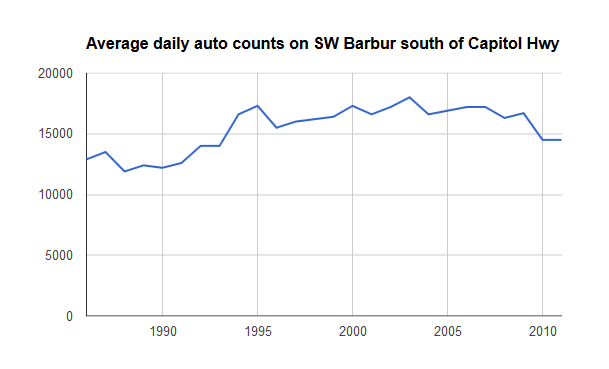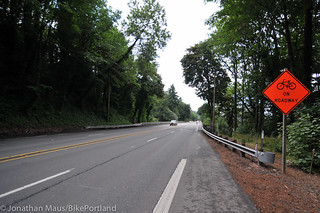A state memo that dismissed a set of bike safety improvements on Southwest Barbur Boulevard was “wrong” in its use of traffic data, a traffic engineer who helped prepare the data said Wednesday.
Barbur, the only flat and direct route connecting much of Southwest Portland and the rest of the city, currently forces cars and bicycles to merge into the same 45 mph lane in order to cross two narrow bridges. The Oregon Department of Transportation has been under pressure from some nearby residents to explain its unwillingness to restripe the road after a planned repaving job.
As part of its case against replacing one of two northbound auto lanes with two dedicated bike lanes across the bridges, ODOT had cited a report finding that the change might increase travel times somewhere between 10 and 65 percent on the corridor by 2035. (It comes to something like 84 seconds to 9 minutes of additional auto travel time over the course of the 4.9 miles south of the proposed changes.) Among other things, the models assume that no one will ever change their schedule or mode of travel to avoid that congestion.
But Anthony Buczek, a traffic engineer for regional agency Metro who’s participated in months of negotiations over ways to change the road, said in an interview that those numbers were not the best available and said the two agencies had previously agreed not to release them without agreeing on how to correct their inaccuracies.
“ODOT has done road diets elsewhere in the state. For whatever reason, ODOT Region 1 isn’t on board.”
— Anthony Buczek, Metro travel engineer
“There’s just not enough detail in the model to assess accurately the travel times or the amount of diversion,” said Buczek. “We thought we had communicated that pretty clearly to ODOT, so I think we were a little surprised to see the data released as it was.”
Buczek said the “correct” numbers, if any, came from a subsequent study by Metro and the City of Portland, using Synchro SimTraffic software, that found additional auto travel delays of about 10 percent by 2035, mostly because a restriping would force all northbound cars to drive only as fast as the slowest car.
Afternoon rush-hour travel, meanwhile, might actually be accelerated by dedicated bike lanes, because they would prevent southbound cars from having to share a lane with bikes. No studies have yet looked into southbound traffic impacts.
Meanwhile, as some readers noted in the comments below our story last week, actual auto traffic on Barbur in the relevant area peaked in 2003:

This was around the same time that total auto miles traveled in Oregon began falling statewide, and five years before the latest recession.
Even the most dramatic assessments of adding solid bike lanes predict that in the short term, restriping Barbur would increase northbound auto travel time during the morning rush hour by 15 percent, or about 40 additional seconds on the 1.8 miles between Terwilliger Boulevard and Hamilton Street.
In Wednesday’s interview, Buczek said ODOT’s memo by active transportation liaison Jessica Horning implied a false equivalence between the two studies by saying that the long-term results of restriping Barbur “would likely fall somewhere in between” the two estimates of additional auto delay in 2035, 10 percent and 65 percent.
“That’s wrong,” Buczek said. “We think the numbers coming out of SimTraffic are the accurate ones.”
Buczek added that replacing a northbound auto lane with one bike lane in each direction wouldn’t reduce the number of cars that can fit on the roadway during rush hour, it’d just slightly reduce the speed at which many of them do so.
“The capacity constraint remains at the signal at Terwilliger at the south end,” Buczek said. “It does slow things down, because the slowest car’s going to dictate the flow of traffic when you only have one lane. But it doesn’t really reduce the capacity, or at least not very much. And that’s why the impacts are at least minor to modedrate, I would say.”
ODOT spokesman Don Hamilton responded Thursday to Buczek’s criticisms by saying that both projections predict auto delays.
“Both the DTA and Synchro models showed similar results, that the road diet proposal would mean delays and diversion.”
— Don Hamilton, ODOT spokesman
“Both the DTA and Synchro models showed similar results, that the road diet proposal would mean delays and diversion along the Southwest Barbur Boulevard corridor,” Hamilton said. “They differed in their projections as to the extent of the delays but these are just models and not expected to produce precise results.”
Buczek, who specializes in assessing the effects of removing auto travel lanes, said he sees an institutional resistance to reducing selected auto speeds not in the entire ODOT institution but specifically in ODOT’s Region 1, which includes the Portland metro area.
“ODOT Region 1 is generally not supportive of road diet projects. I can’t think of one that they’ve done in the region,” Buczek said. “Which is unfortunate, because we know from national studies and the Federal Highway Administration that road diet projects do improve safety where they’re done thoughtfully. But there’s just a resistence from ODOT Region 1. And I think this is an ODOT Region 1 issue rather than an ODOT issue … I believe ODOT has done road diets elsewhere in the state. … For whatever reason, ODOT Region 1 isn’t on board.”
Horning, the ODOT active transportation specialist, disputed that characterization.
“I don’t think it’s fair or accurate to say that Region 1 isn’t supportive of road diets just because Region 3 has done one, but we haven’t done one yet,” she said Wednesday. “If we didn’t believe that road diets can be a useful tool, we wouldn’t have agreed to analyze it as an option.”



